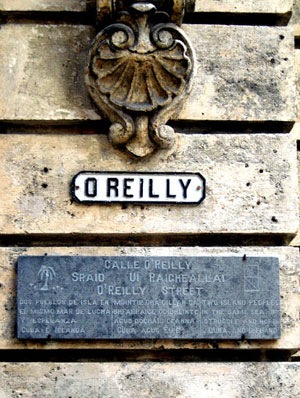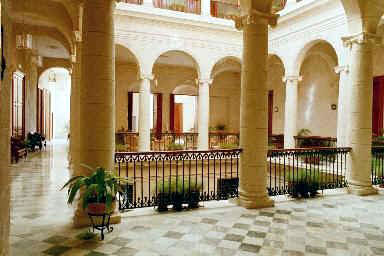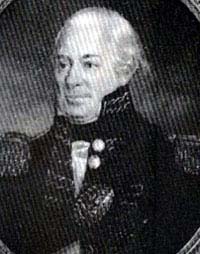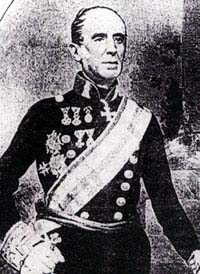|

Corner of O'Reilly and
Tacón streets
at Havana's Plaza de Armas
(Rafael Fernández Moya, 2007)
|
The
villa of San Cristóbal de la Habana, founded in 1519 on
the north coast of Cuba, was visited sixty years later by
sailors and passengers from England and other countries.
In 1609 the governor Ruíz de Pereda informed the Spanish
king that many foreigners were arriving to the island,
amongst them Irish people. Due to the lack of experienced
seamen, many of these foreigners were enlisted in the
Spanish navy.
Political events in England during the seventeenth
century, and particularly the clashes between Protestants
and Catholics in Ireland, prompted a mass emigration of
Irish people to Spain and the protection of the Catholic
Monarchs. After the defeat of James II of England and the
Catholics in Ireland, whose last stronghold was
surrendered in October 1691, several thousand Irish
followers of the king left the country, many of them
joining the armies of other European countries. For
example, for a long period of its history Spain maintained
four regiments made up entirely of Irishmen, with their
own uniform and officers, some of whom served in the
Spanish territories overseas, among them the island of
Cuba.
In
1665 Juan Duany, whose father was a native of the province of Connaught, travelled to Santiago de Cuba in the
east of the country to take part in that city’s
fortification works. A son of his named Ambrosio Duany y
Fallon, from Briggs in Sligo, laid claim to the status
enjoyed by Irish Catholics and allies in the Spanish legal
regime by Royal Cédula of 28 June 1701. Ambrosio
Duany was a consular representative, commander of the
city’s militia and owner of a sugar plantation called “Yarayabo”.
He died in Santiago de Cuba in 1738 and one of his
descendants, Andrés Duany y Valiente received the title of
Count of Duany in 1864.
Throughout the eighteenth century citizens with the
surname Duany held office as council members and mayors of
the City Hall of Santiago de Cuba. In the middle of the
twentieth century a central neighbourhood of the
city was named Castillo Duany after Demetrio Castillo
Duany, general in the Cuban Liberation Army and civil
Governor during the first American intervention
(1898–1902), and a street that leads into the port’s
Alameda carries the name of Joaquín Castillo Duany, also a
general in the Liberation Army. Count Andrés Duany owned
land in the modern-day province of Holguín in the east of
the island, and his surname is the name of a village near
Alto Cedro.
On 26
March 1713 the English Slave-Trading Agreement (asiento)
was signed, which would remain in force for thirty years,
and for this purpose the South Sea Company was created and
obtained the monopoly for supplying enslaved Africans to
all the Spanish possessions. Ricardo O’Farrill and Wergent
Nicholson ran a company in Havana which also had a branch
in Santiago de Cuba run by Messrs. Cumberlege and Walsh.
|

Palacio O'Farrill in
Old Havana, former residence of José Ricardo
O'Farrill, grandson of Ricardo O'Farrill y O'Daly.
(Cuba Travel, 2005)
|
Ricardo O’Farrill y O’Daly was a native of the Caribbean
island of Montserrat and a descendant of a family whose
lineage traces back to County Longford. He married María
Josefa de Arriola y García de Londoño in 1720 and both
would establish a prominent family in the administration,
economy and cultural development of the country, as well
as at the heart of the Spanish-Cuban aristocracy. The
surname O´Farrill appears in the family tree of almost all
the Havana families with noble titles.
At the
beginning of 1721 Ricardo O’Farrill asked to be granted
Spanish citizenship and six months later it was public
knowledge that he had travelled to Jamaica and brought
part of his assets consisting of 236 African men and women
of all ages, 260 barrels of flour, other possessions and
household furnishings, as well as the materials necessary
for the construction of a sugar plantation back in Cuba.
On 17 January of the following year a Royal Cédula
was signed which granted O’Farrill citizenship in Spanish
America and a licence to trade there with the status of
resident of Havana.
Besides working in slave-trading and the import business,
Ricardo O’Farrill became the proprietor of two sugar
plantations located in Sabanilla, adjoining Tapaste,
situated on the road from Havana to Matanzas. The Tapaste
church was built on land donated by descendants of Don
Ricardo, who died in 1730.
It
seems Ricardo O’Farrill had his slave depot on a short
street known as Callejón de O’Farrill (O’Farill’s Alley),
which was also called La Sigua and Las Recogidas, situated
between Picota and Compostela streets, in the port area
and near El Palenque – so called because it was the
State’s African slave depot. In the present day this place
is occupied by the Archivo Nacional (National Archive)
building. The corner of Cuba and Chacón streets is where
Ricardo’s grandson Rafael built his home and is called
O’Farrill’s Corner. This mansion was restored for private
lodging and is now the Hotel Palacio O’Farrill. Nowadays,
in one of the capital’s neighbourhoods, La Víbora, there
is a street called O’Farrill and another called Alcalde
(Mayor) O’Farrill, after one of the Irishman’s descendants
named Juan Ramón O’Farrill, who chaired the City Hall of
Havana at the beginning of the twentieth century.
|

Alejandro O'Reilly
(1722-1794)
(Ramiro Guerra,
Historia de la Nación Cubana, 1952)
|
In
1728 the Irishman Santiago Garvey applied for Spanish
citizenship. He was based in Santiago de Cuba, where
fellow countrymen Juan Francisco Creagh and Juan Rodríguez
Kavanagh were also living. The latter, a native of County
Waterford, was accused of serving as a pilot for the
British troops who landed in Guantánamo Bay that year with
the intention of taking control of the eastern region of
Cuba.
A
powerful British military force attacked the city of
Havana in the summer of 1762 and occupied it until July of
the following year. Among the members of the senior
command of the troops under the command of the Count of
Albemarle was the Quartermaster General Guy Carleton, born
in Strabane, a town in County Tyrone, in the province of
Ulster, who served as the military contingent’s
quartermaster.
During
the British occupation Cornelio Coppinger was a resident
in the capital. Originally from County Cork, he worked as
a slave-trader with the local authorities’ approval. After
the evacuation of the British forces, he remained on the
island and married the Havana woman María López de Gamarra,
with whom he had four sons who excelled in careers in the
military and in government. One of his sons, José
Coppinger, an infantry colonel, was Governor of Bayamo, in
the eastern region of Cuba (1801), Florida (1817-1820),
Veracruz, Mexico, until 1825 and of Trinidad, in the
central region of the island (1834-1837). Cornelio
Coppinger died in Havana around 1786. The historian Manuel
Pérez-Beato states in his book Habana antigua that
the intersection of Cuba and Acosta streets in Havana was
known as Coppinger Corner, but he does not give a reason
why.
|

Pedro Pablo O'Reilly
(Family collection)
|
After
signing a peace treaty with England, Spain regained the
city of Havana in exchange for Florida. In order to
re-establish Spanish control, Ambrosio Funes de
Villalpando, Count of Rica and Lieutenant General of the
Royal Armies, arrived in Cuba on 3 July 1763 accompanied
by several foreign officers in the service of the Spanish
crown among whom was General Alejandro O’Reilly, a native
of
County Meath,
assigned to fill the post of second corporal and
sub-inspector of the armies on the island, and as such the
second military authority in the country.
General O’Reilly finished his mission in Cuba a short time
later, but his first-born, Pedro Pablo, formed a Cuban
family by marrying the Countess of Buenavista, heiress of
the title Marchioness de Jústiz de Santa Ana. As well as
these titles, their descendents added to the possession of
the family those of Marquis of San Felipe y Santiago and
Count of Castillo. However, General O’Reilly is remembered
for having organised the military forces on the island and
particularly the Black and Mulatto Militias. In honour of
his achievements, one of the main streets of the historic
centre of Havana was given his name. A stop on the railway
line situated in the municipal district Quemado de Güines,
in Sagua la Grande in the central region of the country
also bears the name O’Reilly. |




